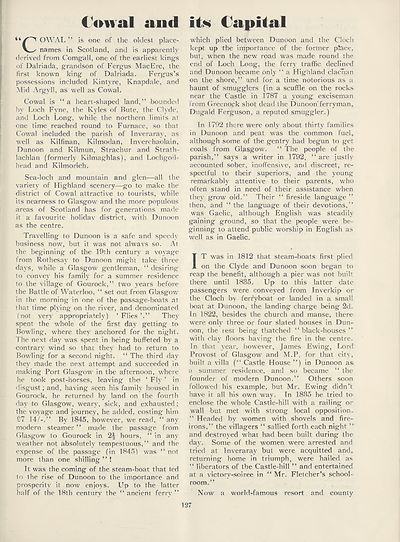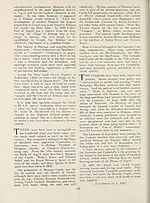An Comunn Gàidhealach Publications > Gaidheal > Volumes 44--45, January 1949--December 1950
(483) Page 127
Download files
Complete book:
Individual page:
Thumbnail gallery: Grid view | List view

I'onal ami it* Capital
“/^OWAL” is one of the oldest plaee-
names in Scotland, and is apparently
derived from Comgall, one of the earliest kings
of Dalriada, grandson of Fergus MacErc, the
first known king of Dalriada. Fergus’s
possessions included Kintyre, Knapdale, and
Mid Argyll, as well as Cowal.
Cowal is “ a heart-shaped land,” bounded
by Loch Fyne, the Kyles of Bute, the Clyde,
and Loch Long, while the northern limits at
one time reached round to Furnace, so that
Cowal included the parish of Inveraray, as
well as Kilfinan, Kilmodan, Inverchaolain,
Dunoon and Kilmun, Strachur and Strath-
lachlan (formerly Kilmaghlas), and Lochgoil-
head and Kilmorich.
Sea-loch and mountain and glen—all the
variety of Highland scenery—go to make the
district of Cowal attractive to tourists, while
its nearness to Glasgow and the more populous
areas of Scotland has for generations made
it a favourite holiday district, with Dunoon
as the centre.
Travelling to Dunoon is a safe and speedy
business now, but it was not always so. At
the beginning of the 19th century a voyage
from Rothesay to Dunoon might take three
days, while a Glasgow gentleman, “ desiring
to convey his family for a summer residence
to the village of Gourock,” two years before
the Battle of Waterloo, “ set out from Glasgow
in the morning in one of the passage-boats at
that time plying on the river, and denominated
(not very appropriately) ‘ Flies They
spent the whole of the first day getting to
Bowling, where they anchored for the night.
The next day was spent in being buffeted by a
contrary wind so that they had to return to
Bowling for a second night. ‘‘ The third day
they rhade the next attempt and succeeded in
making Port Glasgow in the afternoon, where
he took post-horses, leaving the! ‘ Fly ’ in
disgust; and, having seen his family housed in
Gourock, he returned by land on the fourth
day to Glasgow, weary, sick, and exhausted ;
the voyage and journey, he added, costing him
€7 14/-.” By 1845, however, we read, “ any
modern steamer” made the passage from
Glasgow to Gourock in 2^ hours, ” in any
weather not absolutely tempestuous,” and the
expense of the passage (in 1845') was ‘‘ not
more than one shilling ” !
It was the coming of the steam-boat that led
to the rise of Dunoon to the importance and
prosperity it now enjoys. Up to the latter
half of the 18th century the ” ancient ferry ”
which plied between Dunoon and the Clock
kept up the irqportance of the former place,
but, when the new road was made round the
end of Loch Long, the ferry traffic declined
and Dunoon became only ” a Highland clacnan
on the shore,” and for a time notorious as a
haunt of smugglers (in a scuffle on the rocks
near the Castle in 1787 a young exciseman
from Greenock shot dead the Dunoon ferryman,
Dugald Ferguson, a reputed smuggler.)
In 1792 there were only about thirty families
in Dunoop and peat was the common fuel,
although some of the gentry had begun to get
coals from Glasgow. 11 The people of the
parish,” says a writer in 1792, ‘‘ are justly
accounted sober, inoffensive, and discreet, re¬
spectful to their superiors, and the young
remarkably attentive to their parents, who
often stand in need of their assistance when
they grow old.” Their “ fireside language ”
then, and ‘‘ the language of their devotions,”
was Gaelic, although English was steadily
gaining ground, so that the people were be¬
ginning to attend public worship in English as
well as in Gaelic.
IT was in 1812 that steamdjoats first plied
on the Clyde and Dunoon soon began to
reap the benefit, although a pier was not built
there until 1835. Up to this latter date
passengers were conveyed from Inverkip or
the Cloch by ferryboat or landed in a small
boat at Dunoon, the landing charge being 2d.
In 1822, besides the church and manse, there
were only three or four slated houses in Dun¬
oon, the rest being thatched “ black-houses ”
with clay floors having the fire in the centre.
In that year, however, James Ewing, Lord
Provost of Glasgow and M.P. for that city,
built a villa (” Castle House ”) in Dunoon as.
a summer residence, and so became “ the
founder of modern Dunoon.” Others soon
followed his example, but Mr. Ewing didn’t
have it all his own way. In 1835 he tried to
enclose the whole Castle-hill with a railing or
wall but met with strong local opposition.
” Headed by women with shovels and fire-
irons,” the villagers “ sallied forth each night ”
and destroyed what had been built during the
day. Some of the women were arrested and
tried at Inveraray but were acquitted and,
returning home in triumph, were hailed as
“ liberators of the Castle-hill ” and entertained
at a victory-soiree in “ Mr. Fletcher’s school¬
room.”
Now a world-famous resort and county
127
“/^OWAL” is one of the oldest plaee-
names in Scotland, and is apparently
derived from Comgall, one of the earliest kings
of Dalriada, grandson of Fergus MacErc, the
first known king of Dalriada. Fergus’s
possessions included Kintyre, Knapdale, and
Mid Argyll, as well as Cowal.
Cowal is “ a heart-shaped land,” bounded
by Loch Fyne, the Kyles of Bute, the Clyde,
and Loch Long, while the northern limits at
one time reached round to Furnace, so that
Cowal included the parish of Inveraray, as
well as Kilfinan, Kilmodan, Inverchaolain,
Dunoon and Kilmun, Strachur and Strath-
lachlan (formerly Kilmaghlas), and Lochgoil-
head and Kilmorich.
Sea-loch and mountain and glen—all the
variety of Highland scenery—go to make the
district of Cowal attractive to tourists, while
its nearness to Glasgow and the more populous
areas of Scotland has for generations made
it a favourite holiday district, with Dunoon
as the centre.
Travelling to Dunoon is a safe and speedy
business now, but it was not always so. At
the beginning of the 19th century a voyage
from Rothesay to Dunoon might take three
days, while a Glasgow gentleman, “ desiring
to convey his family for a summer residence
to the village of Gourock,” two years before
the Battle of Waterloo, “ set out from Glasgow
in the morning in one of the passage-boats at
that time plying on the river, and denominated
(not very appropriately) ‘ Flies They
spent the whole of the first day getting to
Bowling, where they anchored for the night.
The next day was spent in being buffeted by a
contrary wind so that they had to return to
Bowling for a second night. ‘‘ The third day
they rhade the next attempt and succeeded in
making Port Glasgow in the afternoon, where
he took post-horses, leaving the! ‘ Fly ’ in
disgust; and, having seen his family housed in
Gourock, he returned by land on the fourth
day to Glasgow, weary, sick, and exhausted ;
the voyage and journey, he added, costing him
€7 14/-.” By 1845, however, we read, “ any
modern steamer” made the passage from
Glasgow to Gourock in 2^ hours, ” in any
weather not absolutely tempestuous,” and the
expense of the passage (in 1845') was ‘‘ not
more than one shilling ” !
It was the coming of the steam-boat that led
to the rise of Dunoon to the importance and
prosperity it now enjoys. Up to the latter
half of the 18th century the ” ancient ferry ”
which plied between Dunoon and the Clock
kept up the irqportance of the former place,
but, when the new road was made round the
end of Loch Long, the ferry traffic declined
and Dunoon became only ” a Highland clacnan
on the shore,” and for a time notorious as a
haunt of smugglers (in a scuffle on the rocks
near the Castle in 1787 a young exciseman
from Greenock shot dead the Dunoon ferryman,
Dugald Ferguson, a reputed smuggler.)
In 1792 there were only about thirty families
in Dunoop and peat was the common fuel,
although some of the gentry had begun to get
coals from Glasgow. 11 The people of the
parish,” says a writer in 1792, ‘‘ are justly
accounted sober, inoffensive, and discreet, re¬
spectful to their superiors, and the young
remarkably attentive to their parents, who
often stand in need of their assistance when
they grow old.” Their “ fireside language ”
then, and ‘‘ the language of their devotions,”
was Gaelic, although English was steadily
gaining ground, so that the people were be¬
ginning to attend public worship in English as
well as in Gaelic.
IT was in 1812 that steamdjoats first plied
on the Clyde and Dunoon soon began to
reap the benefit, although a pier was not built
there until 1835. Up to this latter date
passengers were conveyed from Inverkip or
the Cloch by ferryboat or landed in a small
boat at Dunoon, the landing charge being 2d.
In 1822, besides the church and manse, there
were only three or four slated houses in Dun¬
oon, the rest being thatched “ black-houses ”
with clay floors having the fire in the centre.
In that year, however, James Ewing, Lord
Provost of Glasgow and M.P. for that city,
built a villa (” Castle House ”) in Dunoon as.
a summer residence, and so became “ the
founder of modern Dunoon.” Others soon
followed his example, but Mr. Ewing didn’t
have it all his own way. In 1835 he tried to
enclose the whole Castle-hill with a railing or
wall but met with strong local opposition.
” Headed by women with shovels and fire-
irons,” the villagers “ sallied forth each night ”
and destroyed what had been built during the
day. Some of the women were arrested and
tried at Inveraray but were acquitted and,
returning home in triumph, were hailed as
“ liberators of the Castle-hill ” and entertained
at a victory-soiree in “ Mr. Fletcher’s school¬
room.”
Now a world-famous resort and county
127
Set display mode to:
![]() Universal Viewer |
Universal Viewer | ![]() Mirador |
Large image | Transcription
Mirador |
Large image | Transcription
| An Comunn Gàidhealach > An Comunn Gàidhealach Publications > Gaidheal > Volumes 44--45, January 1949--December 1950 > (483) Page 127 |
|---|
| Permanent URL | https://digital.nls.uk/127127832 |
|---|
| Description | This contains items published by An Comunn, which are not specifically Mòd-related. It includes journals, annual reports and corporate documents, policy statements, educational resources and published plays and literature. It is arranged alphabetically by title. |
|---|
| Description | A collection of over 400 items published by An Comunn Gàidhealach, the organisation which promotes Gaelic language and culture and organises the Royal National Mòd. Dating from 1891 up to the present day, the collection includes journals and newspapers, annual reports, educational materials, national Mòd programmes, published Mòd literature and music. |
|---|---|
| Additional NLS resources: |
|

